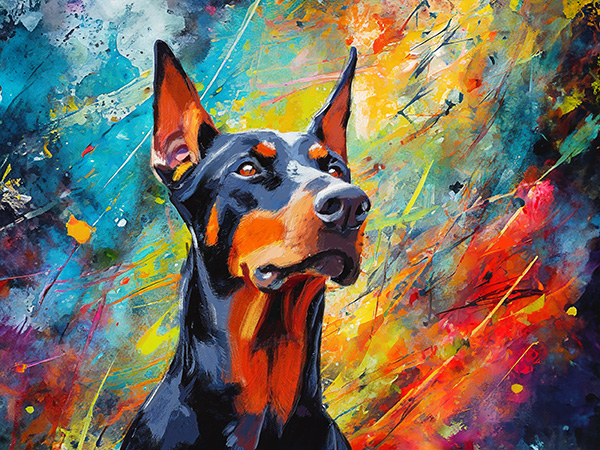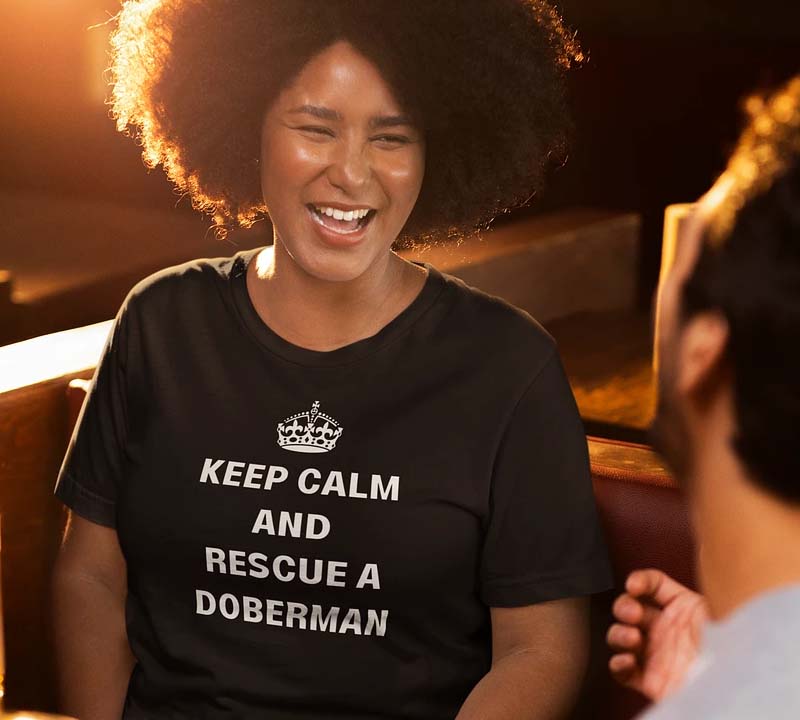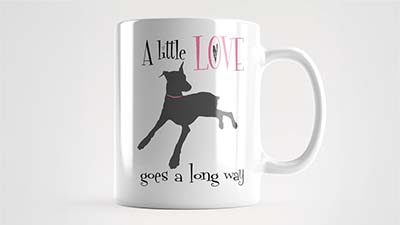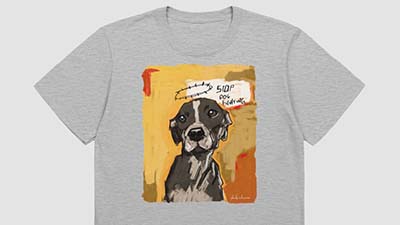Gaze into the eyes of a Doberman, and you'll find yourself in the presence of a truly remarkable breed. As a devoted admirer of these majestic canines, it's a privilege to look into the origins and evolution of the Doberman breed. With a history steeped in purpose and a reputation as one of the most versatile and loyal companions, the Doberman has captured the hearts of dog lovers worldwide.
Brief Overview of the Doberman Breed's Popularity and Characteristics
At first glance, the Doberman presents a striking figure, with its sleek, muscular build and alert and intelligent gaze. Renowned for their unwavering loyalty and unwavering dedication to their families, Dobermans have rightfully earned their place as beloved companions and guardians.
Originally bred by Karl Friedrich Louis Dobermann in the late 19th century, the breed was intended to serve as a fearless protector and versatile working dog. Through careful selection and breeding, Dobermann succeeded in creating a canine counterpart capable of fearlessly defending its territory while remaining gentle and affectionate with its human companions.
Today, the Doberman's popularity extends far beyond its original role as a guardian. From search and rescue missions to therapy work, Dobermans showcase their intelligence, athleticism, and adaptability in a wide range of roles. Yet, amidst their many talents, it's their unwavering loyalty and deep bond with their families that truly sets them apart.
As an enthusiast of the breed, I've witnessed firsthand the indelible mark that Dobermans can leave on the lives of those fortunate enough to share their journey. Join me as we embark in an exploration of the origins and legacy of the remarkable Doberman breed.
Karl Friedrich Louis Dobermann: The Man Behind the Breed
In canine history, few names resonate as profoundly as Karl Friedrich Louis Dobermann. Born in Apolda, Germany, in 1834, Dobermann's legacy extends far beyond his humble origins. A man of many trades, he served as a tax collector in his hometown, a profession that exposed him to the harsh realities of 19th-century society.
It was during his job as a tax collector that Dobermann found himself in need of a loyal and protective companion to go with him on his rounds. As a result, he began experimenting with the breeding of dogs, aiming to create a breed that possessed both the courage to defend its master and the intelligence to navigate the complexities of urban life.
Dobermann's unique position as both a tax collector and dog catcher afforded him access to a diverse array of canine specimens, which he carefully applied selected breeding to achieve his vision. Through a process of trial and error, he gradually refined his breeding program, crossing breeds such as the Rottweiler, German Pinscher, Weimaraner, and Greyhound to create the foundation of what would become the Doberman breed.
Yet, Dobermann's motivations extended beyond mere practicality. In addition to work as a tax collector, he also served as the local dogcatcher, a role that exposed him to the plight of stray and abandoned animals. It's said that Dobermann's desire to create a formidable guardian was fueled, in part, by his desire to protect himself and his community from the dangers posed by feral dogs.
In 1890, just six years before his death, Dobermann's vision was realized with the creation of the breed that would bear his name. Though he did not live to see the full extent of his legacy, his impact on the world of canine breeding endures to this day.
The Breeding Process
Karl Friedrich Louis Dobermann's quest to create the perfect guardian and companion was not without its challenges. The breeding process he embarked upon was a meticulous and deliberate endeavor, marked by careful selection and strategic planning of the myriad steps of the breeding process that gave birth to the Doberman breed.
Selection of Foundational Breeds
Dobermann's breeding program relied on a diverse array of foundational breeds, each chosen for its unique attributes and strengths. The Rottweiler, known for its courage and protective instincts, provided the backbone of the Doberman's temperament and physique. The German Pinscher contributed intelligence, agility, and a sharp, alert demeanor, while the Weimaraner and Greyhound infused the breed with speed, grace, and elegance.
Characteristics Desired in the Breed
Central to Dobermann's vision was the creation of a breed that combined strength with intelligence, courage with loyalty. The ideal Doberman possessed a keen sense of awareness, a fierce devotion to its master, and an unwavering commitment to guarding its territory. Additionally, Dobermann sought to give the breed with a sleek, muscular body and a presence that would command respect wherever it went.
Challenges and Successes in the Breeding Process
The road to perfection was not without its obstacles. Dobermann faced numerous challenges throughout the breeding process, from health issues to temperament concerns. Yet, through persistence and ingenuity, he overcame these hurdles, refining his breeding program with each successive generation. The result was a breed that embodied the very qualities Dobermann had envisioned: fearless, loyal, and utterly devoted to its human companions.
As we reflect on the breeding process that gave rise to the Doberman breed, we gain a deeper appreciation for the dedication and foresight of Karl Friedrich Louis Dobermann. His commitment to creating a canine companion like no other laid the foundation for the enduring legacy of the Doberman, a breed revered for its intelligence, loyalty, and unwavering devotion to duty.
The Foundational Breeds
At the heart of the Doberman breed's lineage lie the foundational breeds carefully selected and strategically crossed by Karl Friedrich Louis Dobermann. These foundational breeds contributed distinct characteristics that shaped the Doberman into the remarkable canine it is today.
The Role of the Rottweiler in the Breed's Development
The Rottweiler, with its imposing size and unwavering loyalty, played a central role in shaping the temperament and physical attributes of the Doberman. Renowned for their courage and protective instincts, Rottweilers imparted a sense of fearlessness and determination to the breed. Additionally, their muscular build and powerful jaws contributed to the Doberman's formidable presence.
Influence of the German Pinscher
The German Pinscher, known for its intelligence and alertness, brought a sharp wit and keen intuition to the Doberman breed. With their lively disposition and innate sense of loyalty, German Pinschers contributed to the Doberman's adaptability and trainability. Their role in the breed's development ensured that Dobermans possessed the mental acuity necessary for their diverse roles as guardians, companions, and working dogs.
Contribution of Other Breeds
In addition to the Rottweiler and German Pinscher, Dobermann incorporated elements from other breeds to further refine the Doberman's characteristics. The Weimaraner, known for its sleek athleticism and keen hunting instincts, added speed and agility to the breed. Similarly, the Greyhound's elegant body and lightning-fast reflexes gave the Doberman with grace and swiftness.
Together, these foundational breeds formed the genetic blueprint for the Doberman, giving the breed a unique blend of strength, intelligence, and loyalty. As we trace the line of the Doberman breed, we recognize the profound influence of these ancestral breeds in shaping the noble and versatile canine companion we know and love today.
The Evolution of the Doberman
From its origins as a guardian and protector to its modern-day roles as a beloved family companion and working dog, the Doberman breed has undergone a remarkable evolution shaped by changing societal needs and values.
Early Roles as a Guardian and Protector
In its early stages, the Doberman breed was primarily bred for its prowess as a guardian and protector. Karl Friedrich Louis Dobermann's original vision for the breed centered around creating a dog capable of fearlessly defending its master and property. As such, early Dobermans were prized for their vigilance, loyalty, and unwavering courage, qualities that made them indispensable companions for those in need of protection.
Transition to Police and Military Work
As urbanization and industrialization swept across Europe, the role of the Doberman expanded beyond the confines of the home. With their keen senses and natural athleticism, Dobermans found themselves in demand for various law enforcement and military applications. From police work to search and rescue missions, Dobermans proved themselves invaluable assets, earning a reputation for their intelligence, trainability, and unwavering dedication to duty.
Shift Towards Companion and Family Pet
In the latter half of the 20th century, the Doberman underwent a significant transformation as it transitioned from a utilitarian working dog to a cherished family companion. As society's perception of dogs evolved, so too did the role of the Doberman. With their gentle disposition, loyalty to their families, and natural affinity for children, Dobermans endeared themselves to households around the world. Today, they are celebrated not only for their protective instincts but also for their affectionate nature and unwavering devotion to their human companions.
As we reflect on the evolution of the Doberman breed, we see a remarkable journey marked by adaptability, resilience, and unwavering loyalty. From its origins as a fearless guardian to its modern-day roles as a cherished family pet, the Doberman exemplifies the timeless bond between humans and their canine companions.
Recognition and Standardization
The journey of the Doberman breed from its humble beginnings to its current status as a beloved companion and working dog has been accompanied by a process of recognition and standardization by kennel clubs and breed organizations worldwide. This section explores the milestones in the breed's recognition and the development of breed standards that define the Doberman's characteristics.
Recognition by Kennel Clubs
The acknowledgment of the Doberman breed by prominent kennel clubs marked a significant milestone in its history. The breed gained recognition for its exceptional qualities, including its intelligence, loyalty, and versatility. Kennel clubs played a crucial role in promoting the breed, facilitating responsible breeding practices, and providing platforms for Doberman enthusiasts to showcase their dogs in conformation shows and performance events.
Development of Breed Standards
With recognition came the need for standardization to ensure the preservation of the breed's distinctive traits and characteristics. Breed standards serve as a blueprint for breeders, judges, and enthusiasts, outlining the ideal physical and temperament attributes of the Doberman. These standards encompass various aspects, including size, coat color, conformation, and temperament, guiding breeders in their efforts to produce dogs that exemplify the breed's essence.
Evolution of the Breed Standard Over Time
The breed standard has evolved over the years to reflect changes in societal preferences, advancements in breeding practices, and shifts in the breed's roles and functions. While the core traits of intelligence, loyalty, and courage remain the same, refinements have been made to enhance the breed's health, temperament, and overall well-being. Breed organizations continually review and update the standard to ensure its relevance and applicability in the modern world.
As we contemplate the recognition and standardization of the Doberman breed, we can see the vital role played by dedicated breeders, enthusiasts, and organizations in preserving and promoting the breed's legacy. Through their collective efforts, the Doberman continues to captivate hearts and minds worldwide, embodying the pinnacle of canine excellence and companionship.
Famous Dobermans
Throughout history, the Doberman breed has captured the imagination of people around the world, leaving an lasting mark in literature, film, and real-life anecdotes. From loyal companions, heroic protectors and even villains, Dobermans have earned their place in the spotlight, both as individual dogs and as symbols of canine excellence. This section celebrates the iconic Dobermans who have left an enduring legacy in popular culture and in the hearts of their admirers.
Notable Individuals Who Owned Dobermans
Dobermans have graced the homes of many notable figures, from celebrities to world leaders. Their intelligence, loyalty, and imposing presence have made them sought-after companions for those in the public eye. Whether guarding the estates of Hollywood stars or serving as trusted companions to political leaders, these Dobermans have left an impression on history through their unwavering devotion and steadfast loyalty.
Some notable personalities who have chosen Dobermans as companions include:
- Hunter S Thompson
- Beatrice Arthur
- Jean-Christophe Novelli
- Bela Lugosi
- Mariah Carey
- William Shatner
- Rudolph Valentino
- Raquel Welch
- John F. Kennedy
- Tanya Roberts
Famous Dobermans in Literature, Film, and Television
The allure of the Doberman breed extends to the realms of literature, film, and television, where they have been portrayed as characters ranging from loyal sidekicks to formidable adversaries. From classic novels to blockbuster movies, Dobermans have captured the imagination of audiences worldwide, their sleek silhouettes and piercing gazes leaving an unforgettable impression on the silver screen.
Literature
Dobermans have been featured in various works of literature, where they are often depicted as loyal companions and guardians. Whether serving as faithful companions to protagonists or playing pivotal roles in the plot, Dobermans have left their mark on the pages of beloved novels and stories.
Film
In the world of cinema, Dobermans have been cast in a variety of roles, ranging from heroic protagonists to menacing villains. Their imposing stature and commanding presence make them a natural fit for roles that require strength, intelligence, and loyalty.
The Doberman Gang
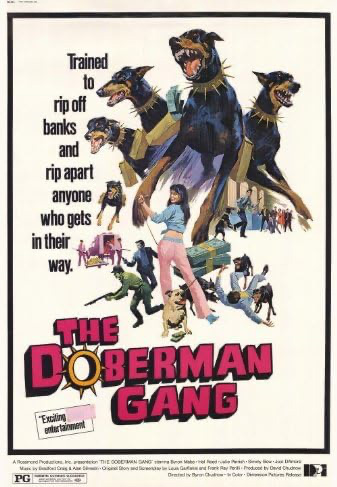
"The Doberman Gang" is a unique film that captured the imagination of audiences in the 1970s with its unconventional premise and canine-centric storyline. Directed by Byron Chudnow and released in 1972, the movie follows a group of six specially trained Doberman Pinschers who are recruited by a criminal mastermind to execute a daring bank robbery.
The film gained attention for its innovative use of trained dogs as central characters, each with its own distinct personality and role in the heist. From the agile "Dollar" to the fearless "Bonnie," the Dobermans showcased their intelligence, agility, and loyalty as they executed their assigned tasks with precision and cunning.
While "The Doberman Gang" was a work of fiction, its portrayal of Dobermans as skilled and capable animals left a lasting impression on audiences and contributed to the breed's reputation as intelligent and trainable companions. However, it also perpetuated stereotypes about the breed's potential for criminality and aggression, reinforcing misconceptions that continue to linger in popular culture to this day.
Despite its mixed impact on the public perception of Dobermans, "The Doberman Gang" remains a cult classic and a testament to the enduring appeal of these remarkable dogs. Through their portrayal on the silver screen, the Dobermans of "The Doberman Gang" left an indelible mark on the hearts and minds of viewers, further solidifying their place in cinematic history.
Beverly Hills Chihuahua
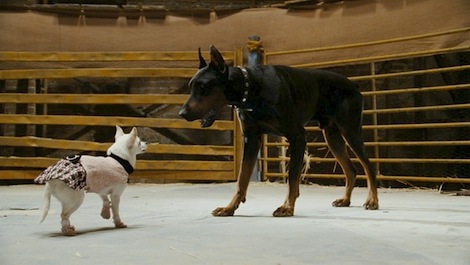
In the movie "Beverly Hills Chihuahua," the Doberman Pinscher plays a significant role as one of the antagonists in the story. Set in the glamorous backdrop of Beverly Hills, the film follows the adventures of a pampered Chihuahua named Chloe who gets lost in Mexico and must find her way back home with the help of new friends.
The Doberman in the movie, named Delgado, initially appears as a menacing and aggressive character, serving as a guard dog for a dogfighting ring. However, as the story unfolds, it is revealed that Delgado has a complex backstory and a softer side beneath his tough exterior. Through his interactions with Chloe and other characters, Delgado undergoes a transformation, ultimately becoming a loyal ally and protector to the protagonists.
While Delgado's portrayal in "Beverly Hills Chihuahua" initially conforms to the stereotype of Dobermans as fierce and intimidating, the film ultimately subverts this stereotype by revealing the character's depth and complexity. As with many cinematic depictions of Dobermans, Delgado serves as a reminder that appearances can be deceiving, and that even the most fearsome-looking dogs can possess qualities of loyalty, courage, and compassion.
Resident Evil
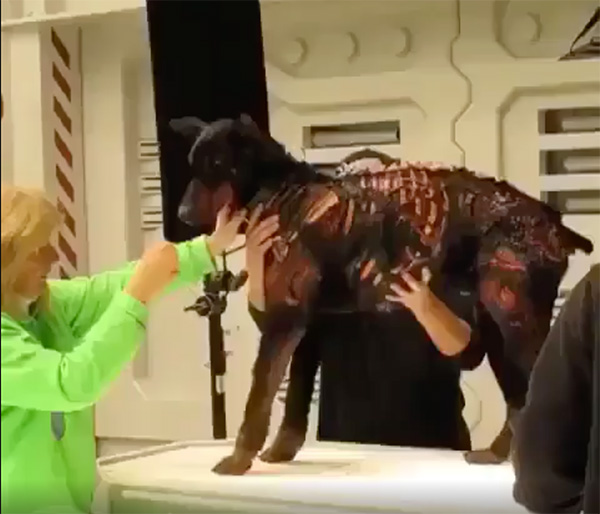
In the film adaptation of the popular video game series "Resident Evil," Dobermans are featured as menacing and formidable adversaries. Set in a dystopian world overrun by zombies and genetically engineered monsters, the Dobermans are depicted as part of the security system guarding the underground Umbrella Corporation facility.
These Dobermans, known as Cerberus, have been genetically enhanced and trained to attack intruders mercilessly. With their sleek black coats and glowing red eyes, they strike fear into the hearts of the protagonists as they relentlessly pursue them through the corridors of the facility.
While the portrayal of Dobermans in "Resident Evil" leans heavily into the stereotype of the breed as aggressive and dangerous, it is important to remember that the film is a work of fiction set in a fantastical and exaggerated world. In reality, Dobermans are known for their intelligence, loyalty, and affectionate nature, and are valued companions in many households around the world.
Despite their antagonistic role in the movie, the presence of Dobermans in "Resident Evil" serves to heighten the tension and suspense, adding an extra layer of danger to the already perilous situation faced by the characters. As with many portrayals of Dobermans in popular media, their appearance in "Resident Evil" underscores the enduring fascination with the breed and its ability to captivate audiences, even in the realm of science fiction and horror.
Television
Dobermans have also made their mark on the small screen, appearing in popular television shows and series. Whether starring in their own canine-centric programs or making guest appearances in dramas and comedies, Dobermans have captivated audiences with their charm, charisma, and undeniable screen presence.
Magnum, P.I.
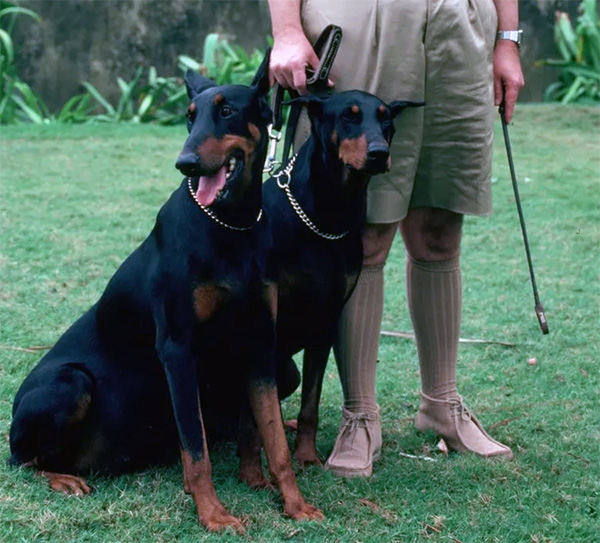
In the popular television series "Magnum, P.I.," which aired from 1980 to 1988, Dobermans played a memorable role as loyal companions to the titular character, Thomas Magnum. The Dobermans, named Zeus and Apollo, belonged to Robin Masters, the mysterious owner of the estate where Magnum lived and worked as a private investigator.
Zeus and Apollo quickly became fan favorites, known for their imposing presence, unwavering loyalty, and occasional mischievous antics. Despite their intimidating appearance, the Dobermans were depicted as affectionate and protective companions to Magnum and his friends, often accompanying them on their adventures and providing valuable assistance in solving cases.
The portrayal of Dobermans in "Magnum, P.I." helped to counteract some of the negative stereotypes surrounding the breed, showcasing them as intelligent, well-trained, and loving animals. Through their interactions with Magnum and the other characters, Zeus and Apollo demonstrated the true essence of the Doberman breed: fiercely loyal, highly trainable, and deeply devoted to their human companions.
Overall, the inclusion of Dobermans in "Magnum, P.I." added depth and warmth to the show's ensemble cast, while also highlighting the unique qualities of the breed. By portraying them as integral members of Magnum's extended family, the series helped to promote a more positive and nuanced understanding of Dobermans in popular culture.
As we reflect on the famous Dobermans who have left an indelible mark on popular culture, we are reminded of the breed's enduring appeal and timeless legacy. Through their portrayal in literature, film, and television, Dobermans continue to inspire and captivate audiences with their intelligence, loyalty, and unwavering devotion.
Misconceptions and Stereotypes
Despite their reputation as loyal and affectionate companions, Dobermans have often been subject to misconceptions and stereotypes that paint them in a negative light. This section aims to address and dispel some of the common myths surrounding the breed's temperament and behavior, shedding light on the true nature of these remarkable dogs.
Addressing Misconceptions About the Breed's Temperament
One of the most prevalent misconceptions about Dobermans is that they are inherently aggressive or dangerous. In reality, Dobermans are known for their intelligence, loyalty, and sensitivity to their surroundings. While they are naturally protective of their families and territory, they are not inherently aggressive without cause. Proper socialization, training, and responsible ownership play crucial roles in shaping a Doberman's temperament and behavior.
Dispelling Myths Surrounding Aggression
Another common misconception about Dobermans is that they are prone to unprovoked aggression towards humans or other animals. In truth, aggression in Dobermans is often a result of fear, insecurity, or lack of socialization rather than inherent viciousness. Like any dog breed, Dobermans require positive reinforcement training, consistent leadership, and early socialization to thrive in various environments.
It's important to recognize that individual temperament can vary among Dobermans, just as it does with any other breed. Responsible breeders prioritize temperament and work diligently to produce well-adjusted puppies with stable temperaments. By understanding and addressing the root causes of aggression, we can foster a better understanding of the breed and dispel unfounded fears and stereotypes.
As we challenge misconceptions and stereotypes surrounding the Doberman breed, we reaffirm our commitment to promoting responsible ownership, education, and advocacy on behalf of these remarkable dogs. By fostering a deeper understanding of the breed's true nature and capabilities, we can help ensure that Dobermans are recognized and appreciated for the loyal, loving companions they truly are.
Modern Day Dobermans
In the contemporary landscape, Dobermans continue to carve out a significant presence, excelling in a wide range of roles and capturing the hearts of dog enthusiasts worldwide. This section explores the diverse roles that Dobermans play in modern society, as well as the challenges they face and the ongoing efforts to preserve and enhance the breed for future generations.
Roles of Dobermans in Contemporary Society
Dobermans are renowned for their versatility and adaptability, and they continue to excel in a variety of roles in modern society. From loyal family companions to skilled working dogs, Dobermans can be found making invaluable contributions in numerous fields, including:Service and Therapy Work
Dobermans are increasingly being recognized for their potential as service and therapy dogs, providing assistance and comfort to individuals with disabilities or special needs. Their intelligence, trainability, and gentle demeanor make them well-suited for these roles, offering support and companionship to those in need.
Search and Rescue
Dobermans possess keen senses and a natural instinct for tracking, making them valuable assets in search and rescue operations. Whether locating missing persons in urban environments or searching for survivors in disaster zones, Dobermans play a crucial role in saving lives and providing hope in times of crisis.
Competitive Sports
Dobermans excel in various canine sports and competitions, including agility, obedience, rally, and protection sports such as IPO and Schutzhund. Their athleticism, intelligence, and drive to work make them formidable competitors in these arenas, showcasing their versatility and adaptability.
Challenges Faced by the Breed Today
Despite their many strengths, Dobermans are not without their challenges in the modern world. Like all breeds, they are susceptible to certain health issues, including dilated cardiomyopathy (DCM), hip dysplasia, and von Willebrand's disease. Responsible breeding practices, health screening, and genetic testing are essential in mitigating these risks and ensuring the long-term health and well-being of the breed.
Additionally, Dobermans may face breed-specific legislation (BSL) and breed bans in certain regions due to misconceptions and stereotypes surrounding the breed's temperament. Advocacy efforts aimed at educating policymakers and the public about the true nature of Dobermans can help combat breed-specific discrimination and promote responsible dog ownership.
Efforts in Breeding and Training for Better Temperament and Health
Breeders and enthusiasts alike are committed to preserving and enhancing the Doberman breed for future generations. Through responsible breeding practices, including health screening, temperament testing, and genetic diversity preservation, breeders strive to produce Dobermans with sound minds and bodies. Additionally, ongoing education and training efforts focus on promoting positive reinforcement methods and strengthening the bond between Dobermans and their owners.
As we look to the future, the enduring legacy of the Doberman breed shines bright, guided by a commitment to excellence, compassion, and responsible stewardship. By embracing their versatility, intelligence, and unwavering loyalty, we ensure that Dobermans continue to make a positive impact in the world and enrich the lives of those fortunate enough to call them companions.
Dobermans and Me
As a devoted admirer and rescuer of Dobermans, I am continually struck by the resilience, loyalty, and unwavering spirit of these remarkable dogs. Throughout history, Dobermans have proven themselves to be steadfast companions, capable of extraordinary feats of bravery and devotion. Yet, despite their countless virtues, it pains me to see that some individuals would abandon or mistreat such wonderful creatures.
In tracing the origins and evolution of the Doberman breed, it becomes abundantly clear that these dogs are not merely pets; they are cherished members of our families, valued partners in our work, and beloved companions in our journeys through life. From their humble beginnings as guardians and protectors to their modern-day roles as service dogs, therapy dogs, and loyal companions, Dobermans have left an indelible mark on the hearts of all who have had the privilege of knowing them.
As we reflect on the challenges faced by the breed today, from health concerns to breed-specific legislation, it is incumbent upon us to stand up and advocate for these noble creatures. Through responsible ownership, education, and advocacy, we can ensure that Dobermans are recognized and appreciated for the incredible individuals they are.
Chica the Doberman
Rescuing Chica the Doberman, was a transformative experience that profoundly impacted my life and enriched it in ways I never imagined. Chica was not just any dog; she was a shining example of all the positive qualities that define the Doberman breed – loyal, affectionate, and fiercely devoted to her family.
From the moment Chica entered our lives, she brought boundless joy and love into our home. Her playful antics, unwavering loyalty, and gentle nature touched our hearts in ways we could never have anticipated. Through her, we discovered the true essence of the Doberman breed – intelligent, spirited, and endlessly loving.
But Chica's impact went beyond our immediate family. Her rescue paved the way for us to become involved in animal rescue and advocacy, opening our eyes to the plight of countless dogs in need of loving homes. Inspired by Chica's resilience and spirit, my wife Carla and I embarked on a mission to rescue as many dogs as we could, providing them with the love, care, and compassion they deserved.
In our journey as rescuers, we found ourselves welcomed into a vibrant and supportive dog community, where like-minded individuals shared our passion for animal welfare and advocacy. Together, we formed an extended family bound by our love for dogs and our commitment to making a difference in their lives. Rescuing Chica was more than just a decision; it was a calling that changed the course of our lives forever. Through her, we discovered the power of love, compassion, and second chances – lessons that continue to shape our lives and inspire us to make a difference in the lives of animals in need. Chica may have been just one dog, but her legacy lives on in the countless lives she touched and the hearts she forever changed.
Selective breeding
Selective breeding, also known as artificial selection, is the process of deliberately choosing and breeding organisms with desirable traits to perpetuate those traits in subsequent generations. This practice is commonly employed in agriculture and animal husbandry to enhance specific traits such as yield, disease resistance, or temperament. By selectively breeding individuals that exhibit desired characteristics, humans can manipulate the genetic composition of a population over time, resulting in organisms that are better suited to particular purposes or environments.
DCM
DCM stands for Dilated Cardiomyopathy, which is a serious and often life-threatening heart condition that can affect dogs. In DCM, the heart muscle becomes weakened and enlarged, leading to decreased heart function and poor circulation of blood throughout the body. This can result in symptoms such as lethargy, weakness, coughing, difficulty breathing, and fainting. DCM can be genetic or acquired and may affect certain breeds more commonly than others. Treatment typically involves managing symptoms and addressing underlying causes, but the prognosis can vary depending on the severity of the condition and the dog's response to treatment.
